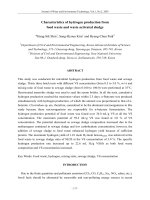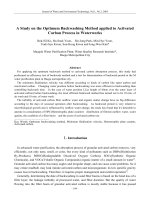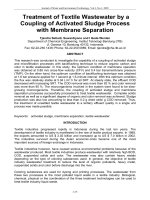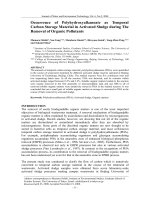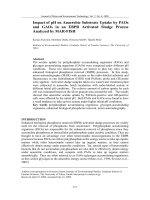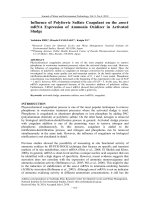ACTIVATED SLUDGE PROCESS
Bạn đang xem bản rút gọn của tài liệu. Xem và tải ngay bản đầy đủ của tài liệu tại đây (3.03 MB, 162 trang )
ACTIVATED SLUDGE
PROCESS
Prepared by
Michigan Department of Environmental Quality
Operator Training and Certification Unit
ACTIVATED SLUDGE
PROCESS
To “Treat”
Wastewater
Remove (reduce) Or “Stabilize”
The Material in Wastewater
SECONDARY TREATMENT
Biological Wastewater Treatment
SECONDARY TREATMENT
Biological Wastewater Treatment
Food
O2
O2 consume organic matter
Microorganisms
from the wastewater, using oxygen for
respiration
Food
Food
O2
O2
Millions of aerobic and facultative micro-organisms
remove pollutants thru living and growing process
Activated Sludge
Suspended Growth,
Biological Treatment
Activated Sludge System
Air →Provides Oxygen and Mixing
Pri.Eff.
Biomass
(suspended)
MLSS
Aeration
Tank
Secondary
Clarifier
Sec. Eff.
Return Activated Sludge (RAS)
Waste Activated Sludge (WAS)
Activated Sludge
Suspended Growth,
Biological Treatment
Need favorable conditions for growth and
for separation from the water
Biological solids are used
over and over
Growth rate produces about
0.7 lbs of biological solids per
lb BOD removed
Primary
Effluent
Return
Sludge
Mixed Liquor
(MLSS)
(MLSS)
Secondary
Clarifier
Aeration Tank
PARTS OF A GENERALIZED BACTERIAL
CELL OF THE BACILLUS TYPE
Capsule
Cell Membrane
Nuclear
Matter
Cell Wall
Flagellum
Wastewater
New Cells
Slime Layer
Oxygen
Food
Storage
Cell
Membrane
Enzymes
(Absorption)
Soluble Organics
Adsorbed
Particle
NH3
CO2
H2O
Mixed Liquor
Flocculation
A process of contact
and adhesion
whereby the particles
of a dispersion
form larger-size
clusters.
Aeration Tank
ADSORPTION
And
ABSORPTION
Secondary
Clarifier
Sludge Processing
and Storage
Land
Application
Effluent
Disinfect
WAS
RAS
Screening
Influent
Grit
Primary
Clarifiers
Aeration
Tanks
Typical Flow-Through
Activated Sludge Plant
Secondary
Clarifiers
Biological Wastewater
Treatment
Three Steps
1. Transfer of Food from Wastewater
to Cell.
Adequate Mixing
Enough Detention Time
Biological Wastewater
Treatment
2. Conversion of Food to New Cells
and Byproducts.
Acclimated Biomass
Useable Food Supply
Adequate D.O.
Proper Nutrient Balance
100 : 5 : 1
C :N:P
Biological Wastewater
Treatment
3. Flocculation and Solids Removal
Proper Mixing
Proper Growth Environment
Secondary Clarification
Biological Wastewater
Treatment
3. Flocculation and Solids Removal
Must Have Controls
Proper Growth Environment
Filamentous Bacteria – Form Strings
Mixed Liquor Does Not Compact - Bulking
Control Factors
Air Biomass Quantity
Organic
Load, F:M
Pri.Eff.
Hydraulic Load
Solids Load
and Age
Aeration
Tank
D.O.
MLSS
Secondary
Clarifier
Sec. Eff.
Settleability
Return Activated Sludge
Waste Activated Sludge
Sludge
Blanket
Depth
Activated Sludge System
Organic Load = Pounds of Organics (BOD)
Coming into Aeration Tank
Pri.Eff.
Aeration
Tank
MLSS
Secondary
Clarifier
Sec. Eff.
CALCULATION OF POUNDS
Pounds =
Conc. x Flow (or Volume) x 8.34 Lbs/gallon
Concentration
Of STUFF
In the
Water
X
Quantity
Of Water
The STUFF
Is In
X
Weight
Of The
Water
CALCULATION OF POUNDS
Pounds =
Conc. x Flow (or Volume) x 8.34 Lbs/gallon
Flow (Volume) and Concentration must be
expressed in specific units.
Concentration must be expressed
as parts per million parts.
Concentration is usually reported as
milligrams per liter.
This unit is equivalent to ppm.
1 mg
liter
=
1 mg
=
1 mg
1000 grams
1,000,000 mg
ppm =
Parts
Mil Parts
=
= ppm
Lbs.
Mil Lbs.
Flow or Volume must be expressed
as millions of gallons:
gallons
= MG
1,000,000 gal/MG
i.e.) A tank contains 1,125,000 gallons of water.
How many million gallons are there?
1,125,000 gal
= 1.125 MG
1,000,000 gal/MG
When Volume is expressed as MG
and concentration is in ppm,
the units cancel to leave only Pounds.
Lbs. =
Concentration x Volume x 8.34 Lbs/gallon
Lbs.
M Lbs.
X
M gal
= Lbs
X
Lbs.
gal
When Flow is expressed as MGD
and concentration is in ppm,
the units cancel to leave Pounds/Day.
Lbs./Day =
Concentration x Flow x 8.34 Lbs/gallon
Lbs.
M Lbs.
X
M gal
Day
X
= Lbs/Day
Lbs.
gal
